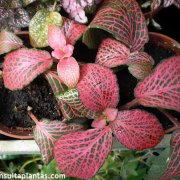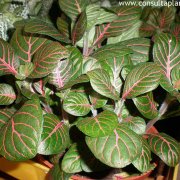Care of the indoor plant Fittonia albivenis or Nerve Plant |
|
The genus Fittonia, family Acanthaceae, includes 2 species of herbaceous plants native to tropical regions of Peru and Brazil. The species are: Fittonia gigantea and Fittonia albivenis (the different cultivars come from this species). Common names: Nerve Plant, Mosaic Plant. This species is native to Peru. They are perennial herbaceous plants that reach 40 cm (15.74") in height. The attractive ovate leaves appear along the stem in pairs. Most attractive are the leaf veins: in Fittonia verschaffeltii "Argironeura" they are silver and in Fittonia verschaffeltii "Pearcei" they are red. The flowers are insignificant. Nerve Plant is used as a houseplant in humid and warm rooms, in greenhouses and in terrariums. It's ideal for growing in pots alongside other taller houseplants. It's an easy to grow but delicate plant. Fittonia should not be placed in direct sunlight because the leaves are burned. It needs good lighting so as not to lose the beautiful colors of the leaves. The soil can be a peaty, light and well-drained substrate with coarse sand. The transplant is done in spring. Water regularly all year round with lime-free water so that the substrate never dries (never water). In winter you have to water less but without letting the soil dry out. In summer spray the leaves with warm water (no lime); they need high humidity. The ideal temperature is 25-27 ºC (77-80.6 ºF); it does not resist temperatures below 15 ºC (59 ºF). Fertilize every 15 days with mineral fertilizer during spring and summer. Mosaic Plant can be lightly pruned at any time to keep them compact. The main dangers for Fittonia albivenis are drafts, aphids, drought, and overwatering. Nerve Plant is propagated in spring or summer by stem cuttings. |
Images of the indoor plant Fittonia albivenis or Nerve Plant |
Find plants
Fittonia albivenis or Nerve Plant | Care and Growing
© 2025 FavThemes








